Ground School 3 - Airports, Air Traffic Control, and Airspace
1/159
There's no tags or description
Looks like no tags are added yet.
Name | Mastery | Learn | Test | Matching | Spaced |
|---|
No study sessions yet.
160 Terms
The numbers 8 and 26 on the approach ends of the runway indicate that the runway is orientated approximately
080 degrees and 260 degrees magnetic.
The numbers 9 and 27 on a runway indicate that the runway is oriented approximately
090 degrees and 270 degrees magnetic.
Enhanced taxiway centerline markings are enhanced for a maximum of how many feet prior to the runway holding position markings?
150 feet
The purpose of an enhanced taxiway centerline is to
highlight an approaching runway holding position marking.
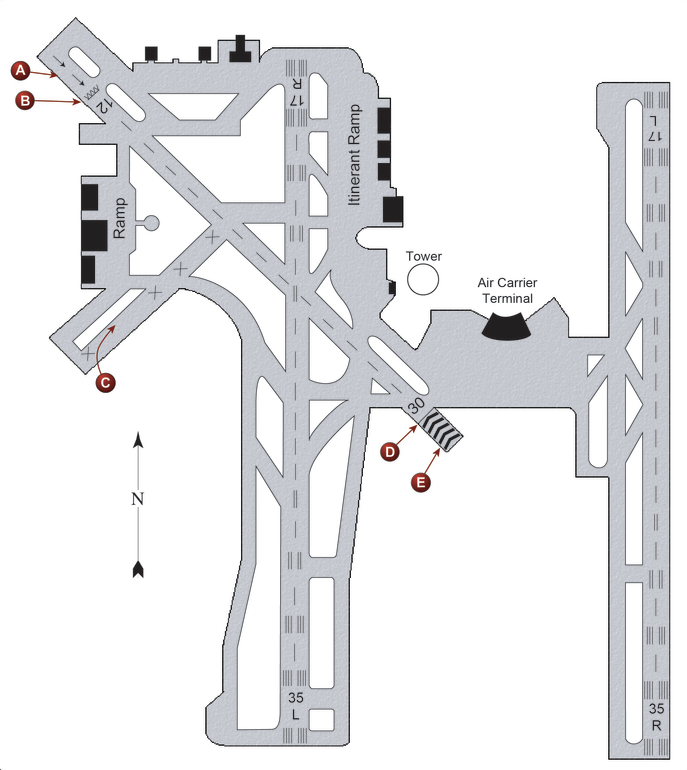
According to the airport diagram, takeoffs may be started at position ___ on Runway 12, and the landing portion of this runway begins at position ___
A, B
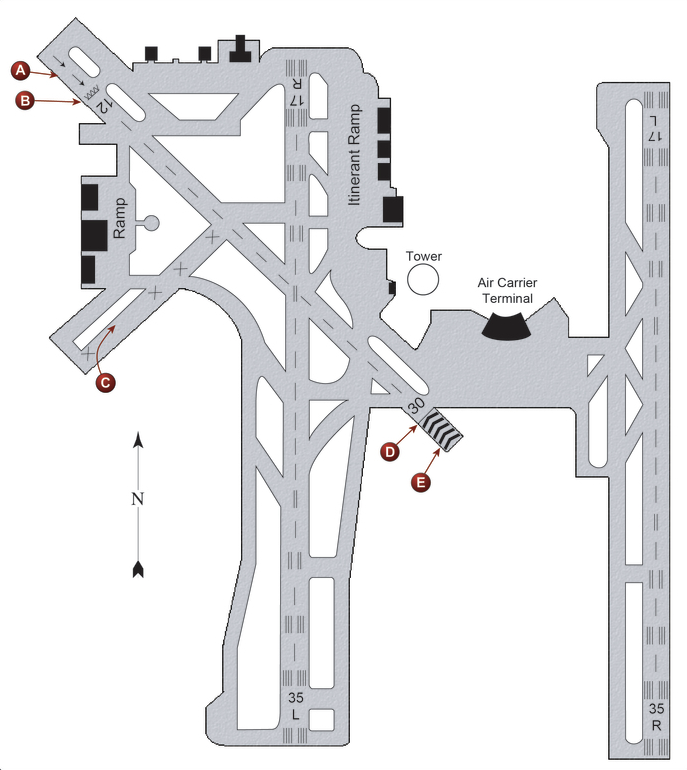
What is the difference between area A and area E on the airport depicted?
“A” may be used for taxi and takeoff; “E” may be used only as an overrun.
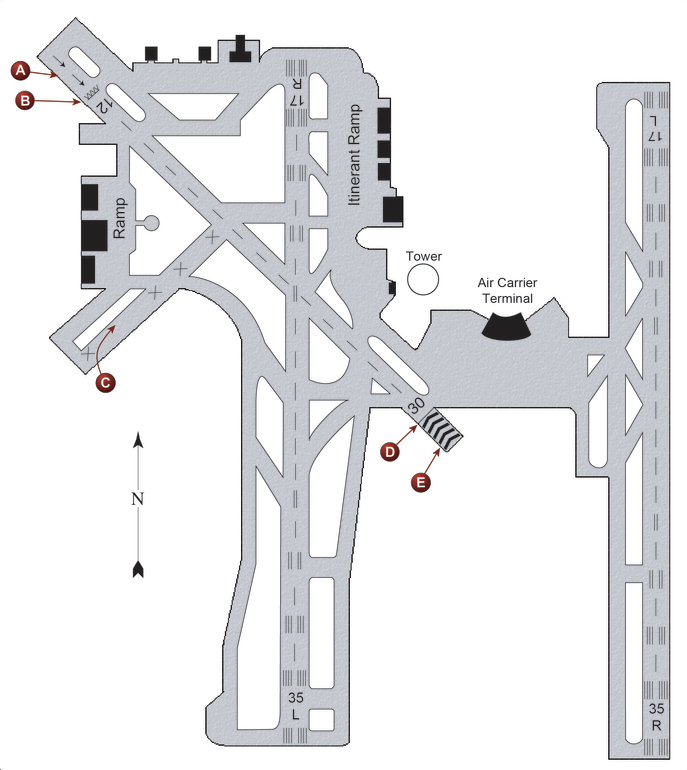
Area C on the airport depicted is classified as a
closed taxiway.
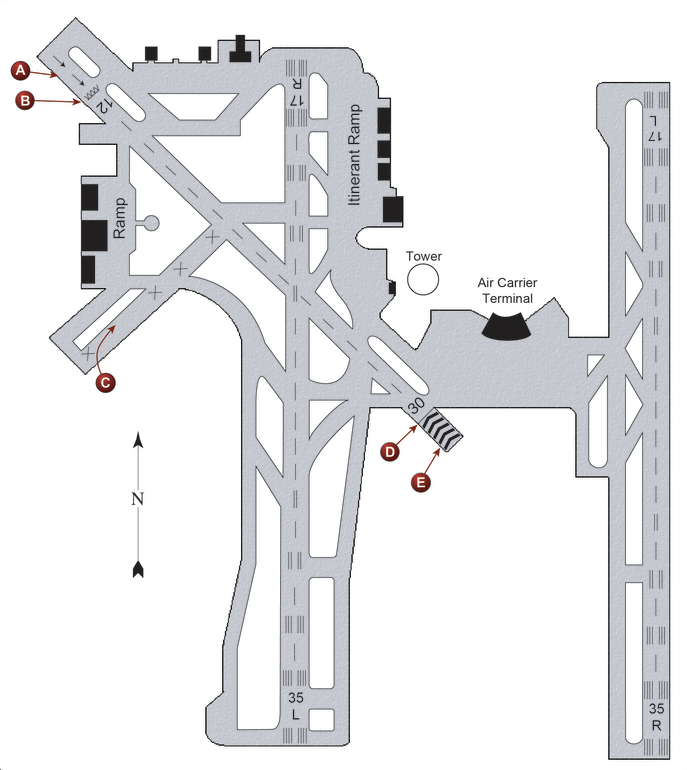
The portion of the runway identified by the letter A may be used for
taxiing and takeoff.
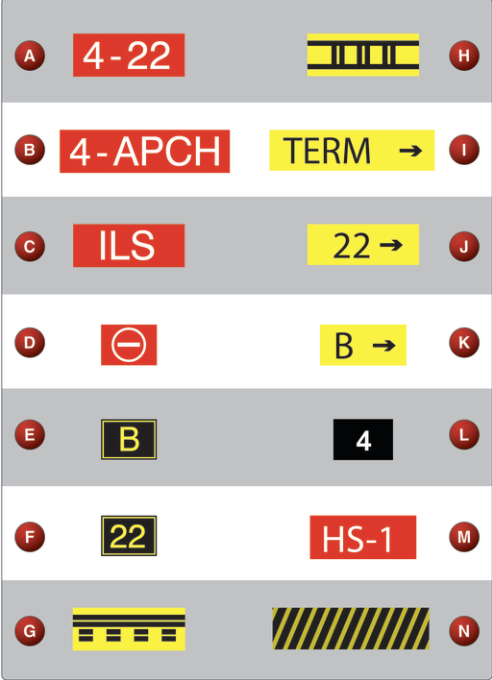
Which of the signs on the figure is a mandatory instruction sign?
A, B, C, D, M

Which sign is a designation and direction of an exit taxiway from a runway?
K
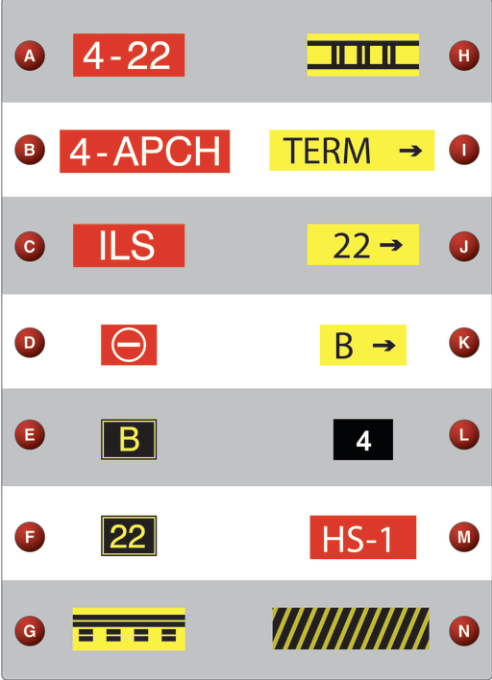
Which sign identifies where aircraft are prohibited from entering?
D
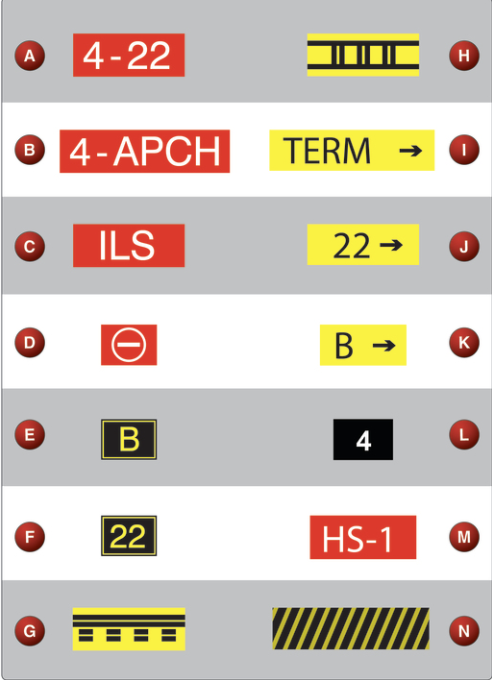
Sign E is a visual clue that
confirms the aircraft’s location to be on taxiway “B.”
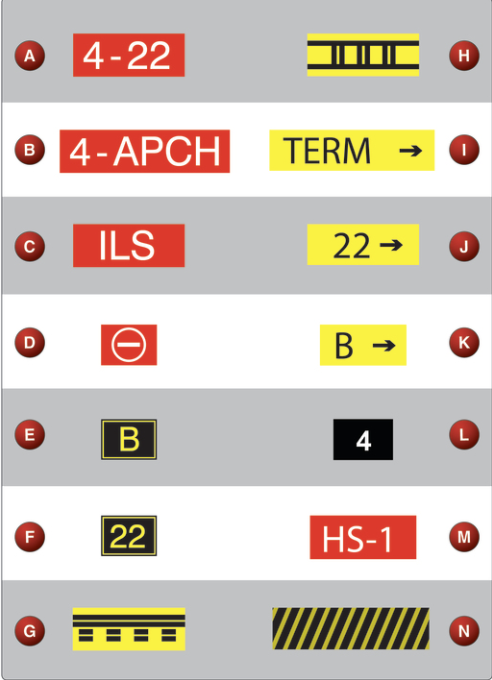
Sign F confirms your position on
Runway 22
What is the purpose of the runway/runway hold position sign?
Denotes intersecting runways
What does the outbound destination sign identify?
Identifies direction to take-off runways.
When approaching taxiway holding lines from the side with the continuous lines, the pilot
should not cross the lines without ATC clearance.
When turning onto a taxiway from another taxiway, what is the purpose of the taxiway directional sign?
Indicates designation and direction of taxiway leading out of an intersection.
What purpose does the taxiway location sign serve?
Identifies taxiway on which an aircraft is located?
The ‘yellow demarcation bar’ marking indicates
runway with a displaced threshold that precedes the runway.
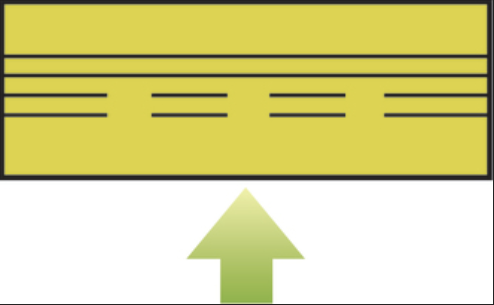
From the flight deck, this marking confirms the aircraft to be
on a runway, about to clear.
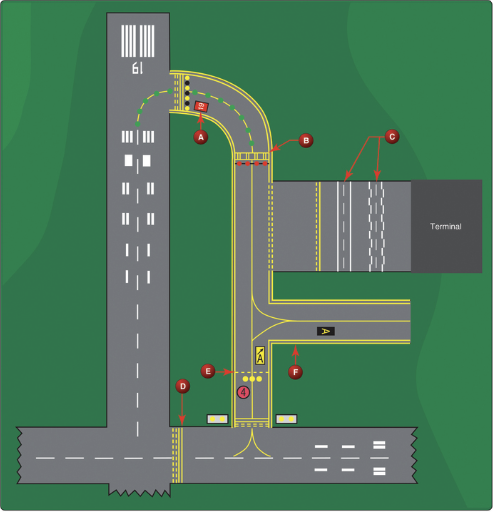
Which marking indicates a vehicle lane?
C
A lighted heliport may be identified by a
green, yellow, and white rotating beacon.
A military air station can be identified by a rotating beacon that emits
two quick, white flashes between green flashes.
An airport’s rotating beacon operated during daylight hours indicates
that weather at the airport located in Class D airspace is below basic VFR weather minimums.
How can a military airport be identified at night?
Two quick white flashes between green flashes.
Airport taxiway edge lights are identified at night by
blue omnidirectional lights.
To set the high intensity runway lights on medium intensity, the pilot should click the microphone seven times, then click it
five times within 5 seconds.
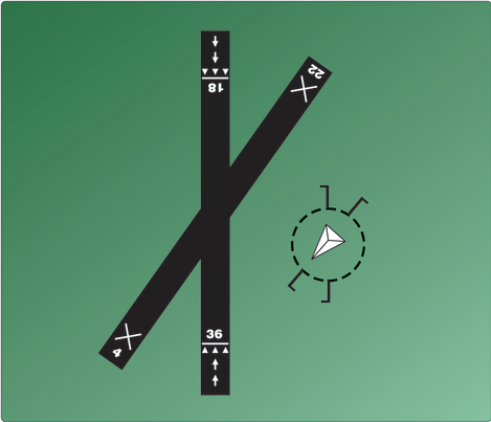
If the wind is as shown by the landing direction indicator, the pilot should land on
Runway 18 and expect a crosswind from the right.
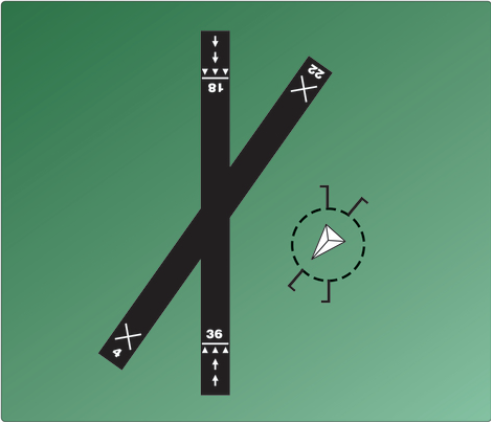
The arrows that appear on the end of the north/south runway indicate that the area
cannot be used for landing, but may be used for taxiing and takeoff.
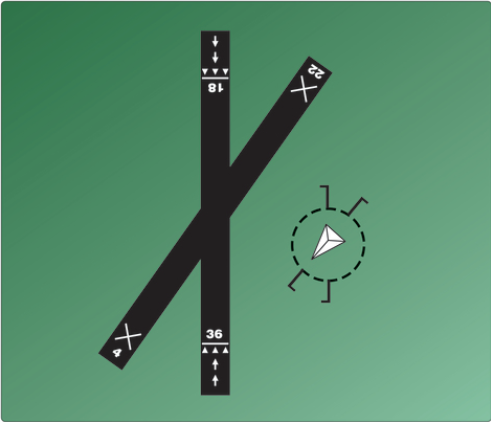
What is the proper traffic pattern and runway for landing?
Right-hand traffic and Runway 18.
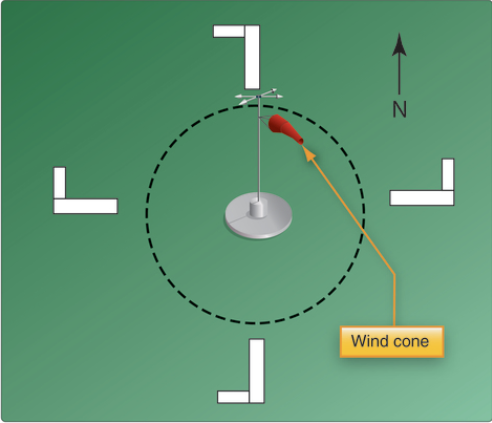
Which runway and traffic pattern should be used as indicated by the wind cone in the segmented circle?
Left-hand traffic on Runway 36.
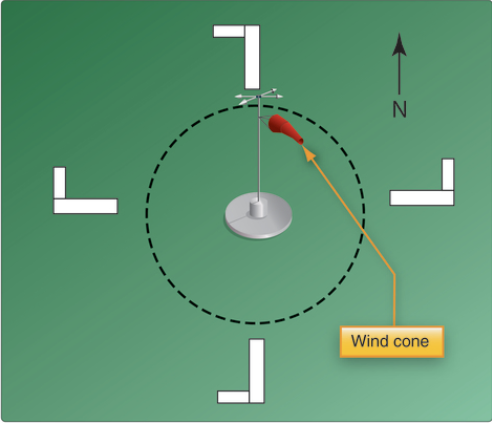
The segmented circle indicates that the airport traffic pattern is
left-hand for Runway 36 and right-hand for Runway 18.
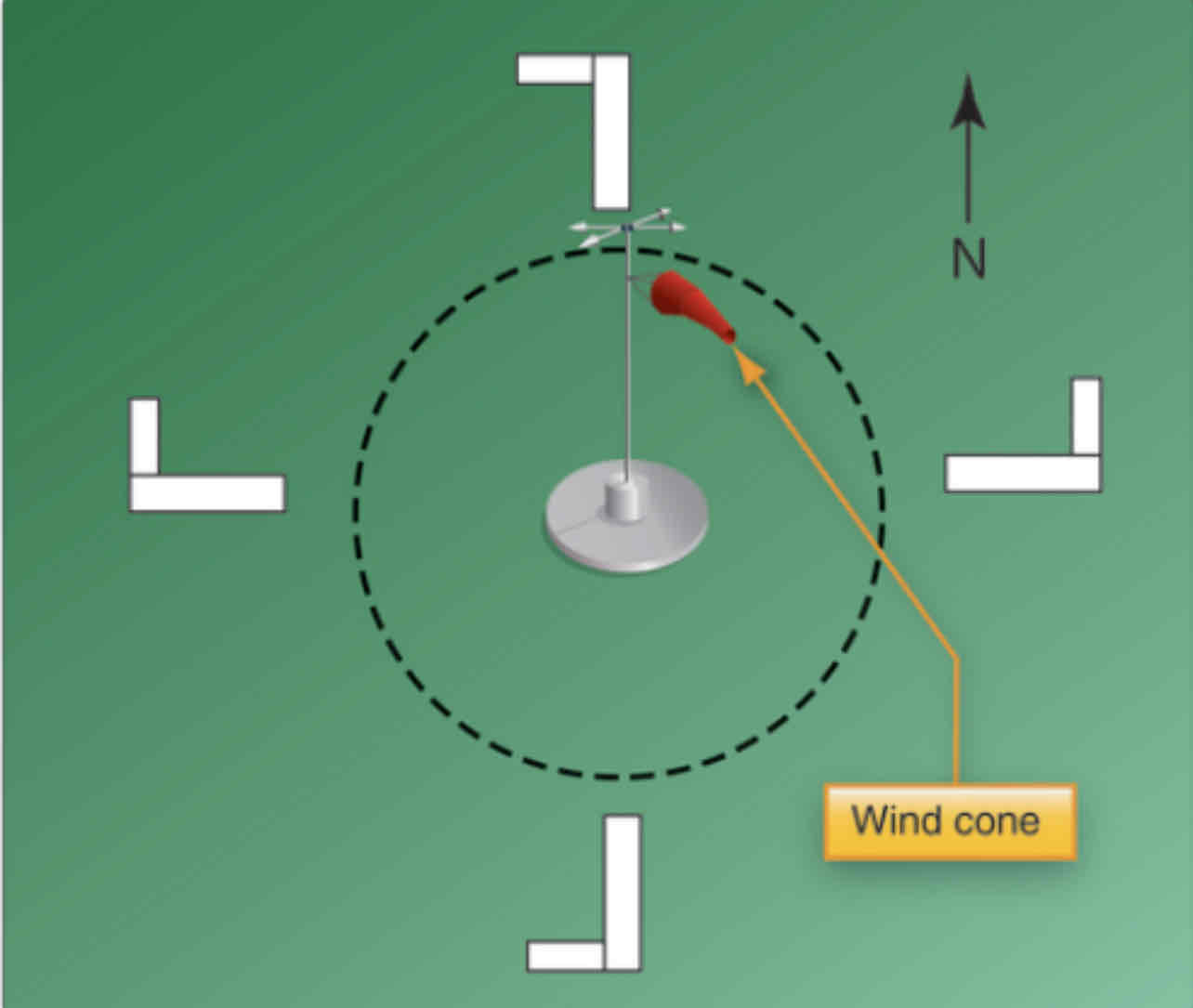
The traffic patterns indicated in the segmented circle have been arranged to avoid flights over an area to the
southeast of the airport.
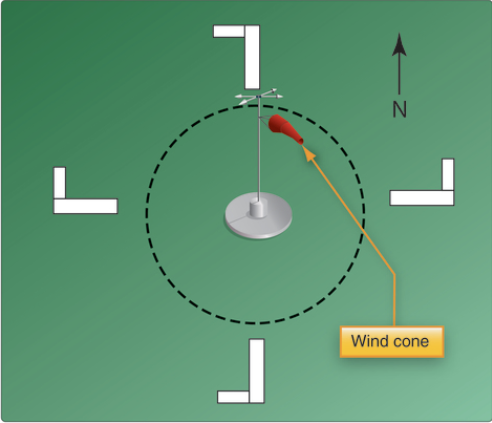
The segmented circle indicates that a landing on Runway 26 will be with a
right-quartering headwind.
What is the correct traffic pattern departure procedure to use at a noncontrolled airport?
Comply with any FAA traffic pattern established for the airport.
The recommended entry position to an airport traffic pattern is
to enter 45 degrees at the midpoint of the downwind leg at traffic pattern altitude.
You are on approach to land on Runway 19 of a non-towered airport. You observe ripples on the southeast of a small lake ¾ miles east of the airport. What is the most appropriate course of action?
Check the windsock to determine the appropriate runway.
A below glide slope indication from a pulsating approach slope indicator is a
pulsating red light.
While operating in class D airspace, each pilot of an aircraft approaching to land on a runway served by a visual approach slope indicator shall
maintain an altitude at or above the glide slope until a lower altitude is necessary for a safe landing.
Which approach and landing objective is assured when the pilot remains on the proper glidepath of the VASI?
Safe obstruction clearance in the approach area.
Each pilot of an aircraft approaching to land on a runway served by a visual approach slope indicator shall
maintain an altitude at or above the glide slope.
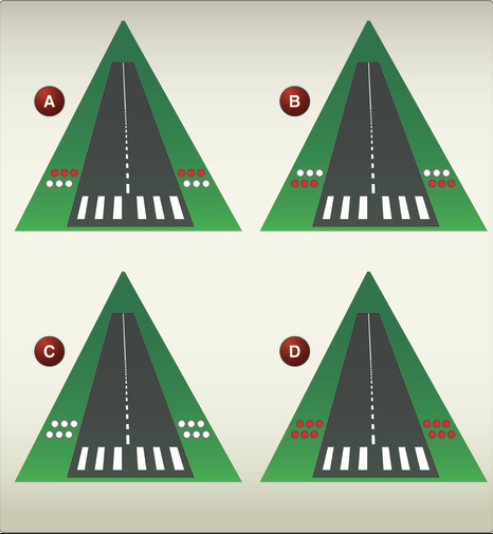
Illustration A indicates that the aircraft is
on the glide slope.
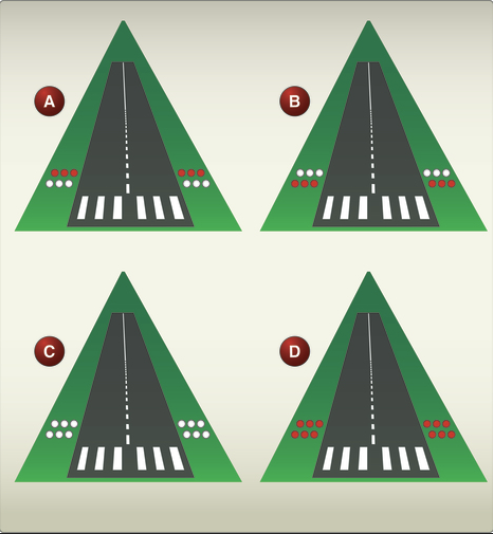
Illustration D indicates that the aircraft is
below the glide slope.
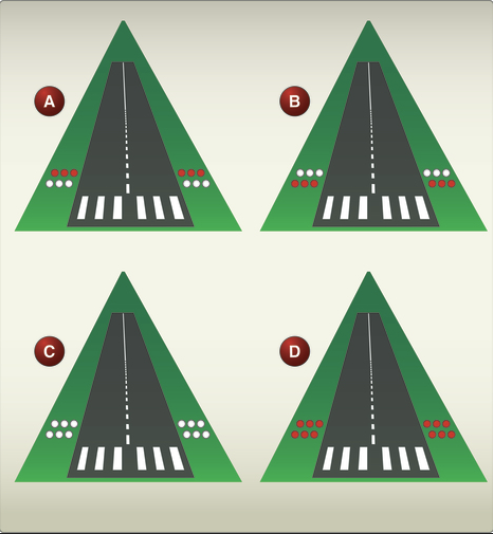
Illustration C indicates that the aircraft is
above the glide slope.
A slightly high glide slope indication from a precision approach path indicator is
three white lights and one red light.
Wingtip vortices are created only when an aircraft is
developing lift.
Wingtip vortices created by large aircraft tend to
sink below the aircraft generating turbulence.
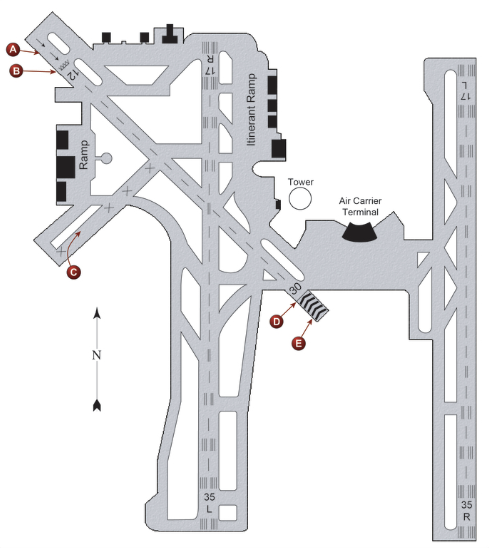
With winds reported as from 300° at 4 knots, you are given instructions to taxi to runway 30 for departure and to expect to take off after an airliner, which is departing from runway 35L. What effect would you expect from the airliner’s vortices?
The winds will push the vortices into your takeoff path.
When taking off or landing at an airport where heavy aircraft are operating, one should be particularly alert to the hazards of wingtip vortices because this turbulence tends to
sink into the flightpath of aircraft operating below the aircraft generating the turbulence.
When landing behind a large aircraft, the pilot should avoid wake turbulence by staying
above the large aircraft’s final approach path and landing beyond the large aircraft’s touchdown point.
The wind condition that requires maximum caution when avoiding wake turbulence on landing is a
light, quartering tailwind.
How does the wake turbulence vortex circulate around each wingtip?
Outward, upward, and around each tip.
When landing behind a large aircraft, which procedure should be followed for vortex avoidance?
Stay above its final approach flightpath all the way to touchdown.
The greatest vortex strength occurs when the generating aircraft is
heavy, clean, and slow.
When departing behind a heavy aircraft, the pilot should avoid wake turbulence by maneuvering the aircraft
above and upwind from the heavy aircraft.
Your flight takes you in the path of a large aircraft. In order to avoid the vortices you should fly
above the flight path of the large aircraft.
During a night flight, you observe a steady red light and a flashing red light ahead and at the same altitude. What is the general direction of movement of the other aircraft?
The other aircraft is crossing to the left.
During a night flight, you observe a steady white light and a flashing red light ahead and at the same altitude. What is the general direction of movement of the other aircraft?
The other aircraft is flying away from you.
During a night flight, you observe steady red and green lights ahead and at the same altitude. What is the general direction of movement of the other aircraft?
The other aircraft is approaching head-on.
How can you determine if another aircraft is on a collision course with your aircraft?
There will be no apparent relative motion between your aircraft and the other aircraft.
Eye movements during daytime collision avoidance scanning should
not exceed 10 degrees and view each sector at least 1 second.
The most effective method of scanning for other aircraft for collision avoidance during daylight hours is to use
a series of short, regularly spaced eye movements to search each 10-degree sector.
Prior to starting each maneuver, pilots should
visually scan the entire area for collision avoidance.
What procedure is recommended when climbing or descending VFR on an airway?
Execute gentle banks left and right for continuous visual scanning of the airspace.
The most effective method of scanning for other aircraft for collision avoidance during nighttime hours is to use
peripheral vision by scanning small sectors and utilizing off-center viewing.
Most midair collision accidents occur during
clear days.
Responsibility for collision avoidance in an alert area rests with
all pilots.
The Aeronautical Information Manual (AIM) specifically encourages pilots to turn on their landing lights when operating below 10,000 feet, day or night, and especially when operating
in conditions of reduced visibility.
It is the responsibility of the pilot and crew to report a near midair collision as a result of proximity of at least
500 feet or less to another aircraft.
ADS-B equipment is not required for aircraft in flight above 10,000 ft. MSL
while that flight is still being conducted below 2,500 ft. AGL.
Can aircraft without ADS-B Out equipment overfly Class C airspace?
Yes, but only in exceptional circumstances because flight over Class C airspace is not permitted without appropriate ADS-B equipment.
ADS-B equipment offers many benefits to pilots; however, the range of coverage for air traffic controllers is
often better than radar, even in remote areas.
Any airspace that requires the use of a transponder also requires aircraft to be
equipped with specific ADS-B Out equipment.
Onboard ADS-B Out equipment is useful to pilots and ATC controllers
all the time, even when aircraft are positioned on the airport surface.
When should ADS-B equipment be operated on the ground while taxiing?
All the time when on the airport surface.
After landing at a tower-controlled airport, when should the pilot contact ground control?
When advised by the tower to do so.
If instructed by ground control to taxi to Runway 9, the pilot may proceed
to the next intersecting runway where further clearance is required.
Automatic Terminal Information Service (ATIS) is the continuous broadcast of recorded information concerning
noncontrol information in selected high-activity terminal areas.
Absence of the sky condition and visibility on an ATIS broadcast indicates that
the ceiling is at least 5,000 feet and visibility is 5 miles or more.
When a control tower located on an airport within Class D airspace ceases operation for the day, what happens to the airspace designation?
The airspace reverts to Class E or a combination of Class E and G airspace during the hours the tower is not in operation.
A non-tower satellite airport, within the same Class D airspace as that designated for the primary airport, requires radio communications be established and maintained with the
primary airport’s control tower.
The lateral dimensions of Class D airspace are based on
the instrument procedures for which the controlled airspace is established.
Unless otherwise authorized, two-way radio communications with Air Traffic Control are required for landings or takeoffs at all towered airports
regardless of weather conditions.
Airspace at an airport with a part-time control tower is classified as Class D airspace only
when the associated control tower is in operation.
When should pilots state their position on the airport when calling the tower for takeoff?
When departing from a runway intersection.
The radius of the procedural outer area of Class C airspace is normally
20 NM.
Under what condition may an aircraft operate from a satellite airport within Class C airspace?
The pilot must contact ATC as soon as practicable after takeoff.
All operations within Class C airspace must be in
an aircraft equipped with a transponder with automatic altitude reporting capability.
Which initial action should a pilot take prior to entering Class C airspace?
Contact approach control on the appropriate frequency.
The vertical limit of Class C airspace above the primary airport is normally
4,000 feet AGL.
Two-way radio communication must be established with the Air Traffic Control facility having jurisdiction over the area prior to entering which class airspace?
Class C.
With certain exceptions, all aircraft within 30 miles of a Class B primary airport from the surface upward to 10,000 feet MSL must be equipped with
an operable transponder having either Mode S or 4096-code capability with Mode C automatic altitude reporting capability.
What minimum pilot certification is required for operation within Class B airspace?
Private Pilot Certificate or Student Pilot Certificate with appropriate logbook endorsements.
The basic VFR weather minimums for operating an aircraft within Class D airspace are
1,000-foot ceiling and 3 miles visibility.
You would like to enter Class B airspace and contact the approach controller. The controller responds to your initial radio call with “N125HF standby.” May you enter the Class B airspace?
You must remain outside Class B airspace until controller gives you a specific clearance.
In which type of airspace are VFR flights prohibited?
Class A.
The minimum flight visibility required for VFR flights above 10,000 feet MSL and more than 1,200 feet AGL in controlled airspace is
5 miles.
VFR flight in controlled airspace above 1,200 feet AGL and below 10,000 feet MSL requires a minimum visibility and vertical cloud clearance of
3 miles, and 500 feet below or 1,000 feet above the clouds in controlled airspace.
For VFR flight operations above 10,000 feet MSL and more than 1,200 feet AGL, the minimum horizontal distance from clouds required is
1 mile.
What minimum flight visibility is required for VFR flight operations on an airway below 10,000 feet MSL?
3 miles.